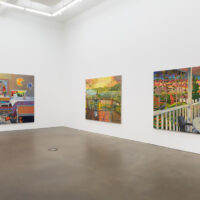Defunct Mnemonics
2012 - Sculpture (Sculpture)
Peter Robinson
Defunct Mnemonics (2012) plays off woodworking traditions found in indigenous art in order to create a body of formally minimal objects that are both beautiful in their restraint and profoundly moving in their associations with the totemic. Resembling large pick-up-sticks, the complete work is comprised of 126 vertical sculptures wrapped in fabric with alternately monochromatic and graphically patterned dyes and prints. Leaning against a wall and arranged side-by-side, they could be mistaken as highly decorated mallets for use in an undetermined ritual or game. These associations with faith and repetition are entirely intended: as part of Robinson’s process, each sculpture was hand carved and finished based on a case of spirit sticks housed at the Museum of New Zealand Te Papa Tongarewa, New Zealand’s national museum and art gallery in Wellington. In order to produce another layer of tactile experience and texture, Robinson wrapped every stick in a roll of concentric felt, in some cases switching between fabrics as means of creating a richly heterogeneous finish to the work. The visual and aural codes at play in Defunct Mnemonics are a reminder of how repetition can help us order ourselves through more deeply felt rhythms. At once both playful and meditative, Robinson’s work encourages us to slow down and retrain our focus through considered visual and metaphorical stops and starts.
Peter Robinson is an artist whose work explores the various cross-sections between materiality, identity, and the indigenous. Many of his works utilize motifs found in Maori art, and his use of woodworking and felted wools often riff on culturally specific materials based in communal craft practices. His clean lines and deliberately restrained forms, though, could be easily placed alongside Minimalist sculpture and feel unselfconsciously modern. Robinson studied at the Ilam School of Fine Arts and has exhibited extensively throughout New Zealand. In 2001, his work was included in the exhibition bi-polar at the Venice Biennale.
Colors:
Related works sharing similar palette
» see more

© » KADIST
Nicolás Paris
2012Nicolas Paris studied architecture and worked as an elementary school teacher before he decided to become an artist...

© » KADIST
Nazgol Ansarinia
2013In the early 2000s, as urban redevelopment accelerated and intense construction significantly diminished public space in Tehran, state-funded murals began to represent imaginary landscapes on building facades...
Related works found in the same semantic group
» see more

© » KADIST
Daniel Boyd
2017Daniel Boyd’s work WTEIA3 is part of a series of paintings that reference the stick charts used by indigenous communities on the Marshall Islands...

© » KADIST
Michael Linares
2014After two years of research in close conversation with anthropologists and archaeologists, Linares eventually enrolled in classes to study archeology—specifically the history of material artifacts...




